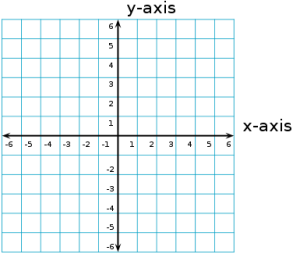Coordinates
Coordinates are a set of numbers (one, two or more of them) that determine the position of a point or a geometric body within a coordinate system. The order of the coordinates is important and it indicates the axis of reference for that specific coordinate. In other words, it tells you which number refers to which axis.
There are several coordinate systems that are widely in use: the number line, the Cartesian coordinate system, the polar coordinate system, cylindrical and spherical coordinate systems. Since the others require some more advanced mathematics that was not covered on this site yet, we are going to turn our attention two the two most commonly used systems – the number line and the Cartesian system.
The number line is probably the first coordinate system you will come across during your education. It is basically a line divided in number of equal parts with a randomly chosen point of origin (O). The coordinate in this system shows the distance of the point in question from the point of origin. If the coordinate is a negative number, it is found on the left side of the point of origin. If it is a positive number, it lays on the right side of the point of origin.
The Cartesian coordinate system is the most well known coordinate system. It was invented in the 17th century by the French philosopher and mathematician René Descartes and it started a revolution in mathematics, as it was the first systematic link between Euclidean geometry and algebra. It can be used to represent two- or three-dimensional space and, depending on that, it consists of two or three mutually perpendicular lines called axes (the singular form is axis).

In the two-dimensional version of the system, the lines are commonly designated as the x-axis (usually the horizontal one) and the y-axis (the vertical one). The point in which the two axes meet is called the point of origin. The coordinates are usually given in pairs, whereas the first number is the distance from the point of origin on the x-axis and the second number is the distance from O on the y-axis. The upper part of the y-axis (above the point of origin) contains the positive values, while the lower part contains the negative values (levitra online). The positive part of the x-axis is the one on the right of the point of origin and the negative part is on the left. The system is divided into four quadrants. The quadrants are most often designated by roman numerals, starting with the upper-right quadrant (usually designated as the first quadrant). From that numbering goes counter-clockwise. In the first quadrant are coordinates with all positive values, such as (1,1), (3,7) and similar. In the second one the coordinates on the x-axis are negative, while the coordinates on the y-axis are positive and so on.
In the three-dimensional version, there are three perpendicular planes, three axes (x,y and z) and the position of a point is determined by three coordinates. Instead of quadrants, the system is divided into octants. The octant in which all three coordinates are positive is considered the first octant, but there are no established rules of nomenclature for the other octants.
The Midpoint formula
The midpoint is defined as the middle point of a line segment. It is equally distant (or equidistant) form both endpoints of the line segment. Depending on the number of dimensions, the position of the midpoint is determined by calculating each of its coordinates one at a time. If you are looking for the midpoint of a line segment on a number line, with endpoints (x1) and (x2), you will use the formula (x1 + x2)/2. The general form of that formula can be applied for all other coordinates in all other dimensions in search of the midpoint.
In a two-dimensional Cartesian system the endpoints will have coordinates (x1, y1) and (x2, y2) which means that to calculate the midpoint of that line segment you will have to calculate its x and y coordinates separately. The formulas you will use will be (x1 + x2)/2 for the x coordinate and (y1 +y2)/2 for the y coordinate.
If you wish to practice finding and plotting coordinates, as well as using the midpoint formula, please use the free worksheets below.
Coordinates exams for teachers
Coordinates worksheets for students
| Worksheet Name | File Size | Downloads | Upload date |
| Coordinates – Define quadrant number | 37.2 MB | 3904 | September 3, 2019 |
| Coordinates – Plot a point | 36 MB | 4299 | September 3, 2019 |
| Coordinates – Detect each point | 34.8 MB | 3454 | September 3, 2019 |
| Midpoint Formula – Integers | 260.5 kB | 3123 | September 3, 2019 |
| Midpoint Formula – Decimals | 326 kB | 2737 | September 3, 2019 |
| Midpoint Formula – Fractions | 517.3 kB | 2282 | September 3, 2019 |
| Midpoint Formula – Line segment | 7.6 MB | 2729 | September 3, 2019 |